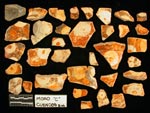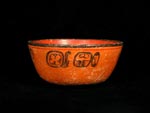
| FAMSI © 2004: Arturo René Muñoz |
|||||||||||||||||||||||||||||||||||||||||||||||||||||||||||||||||||||||||||||||||||||||||||||||||||||||||||||||||||||||||||||||||||||||||
|
The Ceramic Sequence of Piedras Negras, Guatemala: Type and Varieties The Balche Ceramic Phase (A.D. 560–A.D. 620) Balche ceramics have been found in 21 locations across the site, unmixed and in good stratigraphic context with both earlier and later materials. In many cases, Balche phase ceramics are associated with the major renovation of existing structures. A very clear example of this process was the two meters of mixed Naba and Balche materials excavated from the northern end of the West Group Court (Escobedo 1997). This fill likely represents the expansion of the West Group Court in preparation for the construction of Str. K-5-3rd. Distinct features of Balche phase assemblages include the use of specular hematite, the use of painted glyphs or pseudoglyphs, and the use of a true resist technique for decorating polychrome vessels. Though the precise technique by which resist was achieved is unknown, it does appear to have required multiple applications of slip and resist. In most cases, this consisted of an initial dark orange slip resisted against a cream under-slip, the additional application of resisting material and a light orange slip, and finally the application of positively applied black paint. Mataculebra Cream Polychrome, Moro Orange, and Suktan Cream Polychrome are the most common types utilizing this decorative technique. In addition to the resist polychromes, few positive painted types typologically related to Palmar/Saxche groups are common at Piedras Negras. In comparison to Palmar/Saxche ceramics from other Classic Maya sites, the examples from Piedras Negras demonstrate a remarkably limited range of palettes and motifs. The impression gained from this as well as from the distribution of resist decorated ceramics is one of increasing separation from Petén modes, and the development of a unique regional style.
|
|||||||||||||||||||||||||||||||||||||||||||||||||||||||||||||||||||||||||||||||||||||||||||||||||||||||||||||||||||||||||||||||||||||||||
|
Text links to all pages at this site are available at the FAMSI INDEX |
|||||||||||||||||||||||||||||||||||||||||||||||||||||||||||||||||||||||||||||||||||||||||||||||||||||||||||||||||||||||||||||||||||||||||


